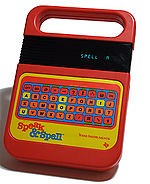
I was recently told about a conference called Game Based Learning. Although I wasn't able to attend in person (and besides, my main research interests are perhaps somewhat tangential to the topic), the subject remains of perpetual interest. One of my colleagues, Liam Green-Hughes, who was lucky enough to be there a couple of weeks ago has written a comprehensive blog post describing some of the themes and presentations.
The appearance of this conference made me begin to reflect on my own experiences of what 'game based learning' means to me. It soon struck me that much of my experiences are from an earlier generation of learning technologies (and I'm not just talking about books!) This post represents a personal history (perhaps a 'retro' history) of using a number of different 'learning' games and devices. I hope, for some, it evokes some fun memories!
Early mobile learning
My first exposure to mobile learning (or learning games) was through a device called Spelling B made by Texas Instruments (now more famous for their DSP processors).
The device presented a truly multi-modal experience. Not only did it contain an alphabetic keyboard, it was also adorned with bright colours and came complete with a picture book. Quite a proportion of the picture book was initially unfathomable since you had to translate the pictures into correctly spelt words.
For quite a long time after using the device, I continued to spell 'colour' incorrectly (or correctly, depending upon your point of view), and believed that all people with peaked hats (who were not witches) were Pilgrims (the historical importance of which was totally lost on a naive British child).
If you spelt some words correctly you got a chirpy bleeping (or buzzing) tune. If you spelt something incorrectly, you were presented with a darker rasping noise.
After around two months of playing, it was game over. I was able to spell, by rote, the one hundred and twenty seven words (or close to it), none of which probably had more than eight characters.
One Christmas I was lucky enough to graduate to the more elegantly designed and ultimately more mind blowing Speak and Spell (wikipedia). It was astonishing to learn that something with batteries could speak to you! Complete with integral handle, rugged membrane board (which you could spill your orange squash onto), an audio connection to prevent parents from going potty (like mine did), and a battery charge length that would put any modern laptop to shame. In my view, the Speak and Spell is a design triumph and you might be able to see some similarities with the OLPC XO computer (if you squint hard enough).
To this day, I remember (without looking at simulations) its rhythmic incantations of 'that is correct! And now spell...' which punctuated my own personal successes and failures.
Learning technology envy
This era of retro learning technology didn't end with the Speak and Spell. One Christmas, Santa gave a group of kids down my street a mobile device called the Little Professor, also from Texas Instruments. Pre-dating the Nintendo DS by decades, this little hand-held beauty presented a true advance in learning technology. When you got a calculation right, the little professors' moustache started to jump around in animated delight. It also incidentally had one of those new fangled Liquid Crystal Display screens rather than the battery hungry LED readouts (but this was inconsequential in comparison to the hilarious moustache).
Learning technology envy was a real phenomenon. I remember a Texas Instruments Speak and Maths devices was undoubtedly more exciting (and desirable to play with) than a lowly Little Professor. Game based learning was a reality, and parent pester power was definitely at work. For those kids who had parents who were well off, the nadir of learning technology envy (when I was growing up) manifested itself in the form of the programmable and mysterious Big Trak.
Big Trak inspired a huge amount of wonderment, especially for those of us who had never been near a logo turtle. The marketing was good as the advertisements of the time (video) testify. It presented kids the opportunity to consider the challenge of creating stored programs.
Learning with the Atari
A number of my peers were Atari 2600 gamers. As well as being enthralled at the prospect of blasting aliens, driving racing cars and battling with dragons represented by pixels the size of a small coins, I gradually became aware of a range of educational games that some retailers were starting to sell.
A number of educational Sesame Street game cartridges were created, presumably with close collaboration wit Atari. I personally found them rather tedious and somewhat unexciting, but an interesting innovation was the presence of a specially designed 'Kids controller'. Each game was provided with a colourful overlay which only presented the buttons that should be used. (As was the case with some Atari games, the box art and instructions leaflets could be arguably more exciting than the game itself).
I have no real idea whether any substantial evaluations were carried out to assess either the user experience of these products, or whether they helped to develop motor control.
Behold! The personal computer...
My first memory of an educational game that was presented through a personal computer was a business game that ran on the BBC Model B. The scenario was that you were the owner of a candy floss store (an obvious attraction for kids) and you had to buy raw materials (sugar) and hope that the weather was good. If it was good, you made money. If it was bad, you didn't. I must add I used this game when Thatcherism was at its peak. This incidental memory connects with wider issues relating to the link between game deployment and wider educational policy, but I digress...
Whilst using the 'candy floss game' I don't have any recollection of having to spend extra money for petrol for the generator or have to pay the council rent (or contend with issues of price rises every year) but I'm sure there was a cost category called 'overheads' that featured somwhere. I'm also pretty sure you could set you own prices of your products and be introduced to the notion of 'breaking even'.
The BBC Model B figured again in my later education when I discovered a business studies lab that was packed with the things, and an occasional Domesday machine, running on an exotically modified BBC Master 128. The Domesday project pointed firmly towards the future. I remember a lunch hour passing in a flash whilst I attempted to navigate through an animated three dimensional exhibition that represented a portal to a range of different encyclopaedic themes.
During business studies classes we didn't use the Beebs (as they were colloquially known) for candy floss stall simulations, but instead we used a program called Edword (educational word processor), a spreadsheet and a simple database program. When we were not using these applications, we were using the luxury of disk drive to play Elite (wikipedia). A magical galaxy drawn in glorious 3D wireframe taught us about commodity trading and law enforcement.
Sir Clive
For a while the Sinclair Spectrum (a firm favorite amongst my peers) was sold with a bonus pack of cassettes. Two memorable ones included an application called Make-A-Chip which allowed you to draw sets of logic gate circuits. You couldn't do much more than create a binary adder, but messing around with it for a couple of hours really helped when it came to understanding these operators when it came to working with real programming languages.
I also have recollections of using a simulation program that allowed you to become a fox or a rabbit (or something else) and forage for food. As the seasons (and years) change, the availability of food fluctuated due to 'natural' changes in population. I never did get the hang of that game: it was a combination of being too slow and not having sufficiently engaging feedback for it to be attractive.
Assessing their impact
If I was asked whether I learnt anything by using the beeping and speaking mobile devices that were mentioned earlier, I couldn't give you an honest answer. I suspect I probably did, and the biggest challenge that researchers face isn't necessarily designing a new technology (which is a challenge that many people grossly underestimate), but understanding the effect the introduction that a particular technology has, and ultimately, whether it facilitates learning.
There is, of course, also a social side to playing learning games (and I write this without any sense of authority!). I remember my peers showing me how to use a Little Professor, and looking at an on-screen 'candy floss sales' graph at feeling thoroughly puzzled at what was being presented to me. A crowd of us used to play that game. Some players, I seem to remember, were more agressive traders than others.
Towards the future
History has yielded an interesting turn of events. I spent many a happy hour messing around on a BBC Model B (albeit mostly playing Elite) and later marveled at its ultimate successor, the Acorn Archimedes (some of the time playing Zarch written by the same author as Elite).
I remember my fascination at discovering it was possible to write programs using the BBC Basic programming language (version 5) without using line numbers. Acorn computer eventually folded but left a lasting legacy in the form of ARM (Acorn Risc Machine), a company that sells its processor designs which have found their way into a whole range of different devices: phones, MP3 players, PDAs.
I recently heard that the designers of the One Laptop Per Child project were considering using ARM-based processors in the second generation designs. The reason for this choice is directed by the need to pay careful consideration to power consumption and the fact that the current processor will not be subject to further on-going development by AMD. (One loosely connected cul-de-sac of history lies with the brief emergence of the inspirational and sadly ill fated Apple eMate, which was also ARM-based).
One dimension of learning games that is outside the immediate requirements of developing skills or knowledge in a particular subject, lies with their potential to engender motivation and enthusiasm.
It's surprising how long electricity powered educational video games and devices have been around for. It's also surprising that it was possible to do so much with so little (in terms of processing power and memory). Educational gaming, I argue, should not be considered as an idea that is considered to be revolutionary. I personally look forwards to learning about what new evolutionary developments are waiting for us around the corner and what they may be able to tell us about how we learn.
